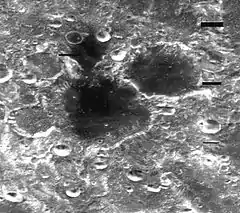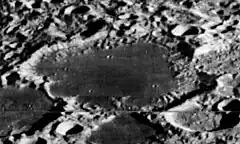 Clementine mosaic | |
| Coordinates | 45°54′S 162°54′E / 45.9°S 162.9°E |
|---|---|
| Diameter | 88 km |
| Depth | Unknown |
| Colongitude | 198° at sunrise |
| Eponym | Henri Chrétien |

Chrétien is a lunar impact crater that is located in the southern hemisphere on the far side of the Moon from the Earth. It lies due south of the Mare Ingenii, one of the few maria on the Moon's far side. The crater lies in the midpoint between the craters Garavito to the west-southwest and Oresme to the east-northeast, both of these being somewhat smaller than Chrétien.
The crater has a low albedo interior floor, which has the same darker hue as the Mare Ingenii to the north. The irregular satellite crater Chrétien C, which shares the straight and narrow northeastern rim of Chrétien, is also covered with this dark basaltic lava. The outer rim of Chrétien is irregular in shape, with several other satellite craters intruding into the sides. The most notable of these are Chrétien S across the southwest rim, and Chrétien W attached to the northwest rim.
The northern rim of Chrétien has a break that joins a small, irregular plain. This area has been resurfaced by the same lava flows that covered the interior of Chrétien. At the southern end, the inner wall forms a wide, irregular surface while the damaged rim bulges outward to the south.
The crater was formally named in 1970 by the IAU after French mathematician and astronomer Henri Chrétien.[1] Before 1970, the crater was known as Crater 427.[2]
Satellite craters
By convention these features are identified on lunar maps by placing the letter on the side of the crater midpoint that is closest to Chrétien.
| Chrétien | Latitude | Longitude | Diameter |
|---|---|---|---|
| A | 43.9° S | 163.6° E | 13 km |
| C | 44.5° S | 165.3° E | 63 km |
| S | 46.5° S | 160.5° E | 40 km |
| W | 44.3° S | 160.8° E | 34 km |
References
- ↑ Chrétien, Gazetteer of Planetary Nomenclature, International Astronomical Union (IAU) Working Group for Planetary System Nomenclature (WGPSN)
- ↑ Lunar Farside Chart (LFC-1A)
- Andersson, L. E.; Whitaker, E. A. (1982). NASA Catalogue of Lunar Nomenclature. NASA RP-1097.
- Blue, Jennifer (July 25, 2007). "Gazetteer of Planetary Nomenclature". USGS. Retrieved 2007-08-05.
- Bussey, B.; Spudis, P. (2004). The Clementine Atlas of the Moon. New York: Cambridge University Press. ISBN 978-0-521-81528-4.
- Cocks, Elijah E.; Cocks, Josiah C. (1995). Who's Who on the Moon: A Biographical Dictionary of Lunar Nomenclature. Tudor Publishers. ISBN 978-0-936389-27-1.
- McDowell, Jonathan (July 15, 2007). "Lunar Nomenclature". Jonathan's Space Report. Retrieved 2007-10-24.
- Menzel, D. H.; Minnaert, M.; Levin, B.; Dollfus, A.; Bell, B. (1971). "Report on Lunar Nomenclature by the Working Group of Commission 17 of the IAU". Space Science Reviews. 12 (2): 136–186. Bibcode:1971SSRv...12..136M. doi:10.1007/BF00171763. S2CID 122125855.
- Moore, Patrick (2001). On the Moon. Sterling Publishing Co. ISBN 978-0-304-35469-6.
- Price, Fred W. (1988). The Moon Observer's Handbook. Cambridge University Press. ISBN 978-0-521-33500-3.
- Rükl, Antonín (1990). Atlas of the Moon. Kalmbach Books. ISBN 978-0-913135-17-4.
- Webb, Rev. T. W. (1962). Celestial Objects for Common Telescopes (6th revised ed.). Dover. ISBN 978-0-486-20917-3.
- Whitaker, Ewen A. (1999). Mapping and Naming the Moon. Cambridge University Press. ISBN 978-0-521-62248-6.
- Wlasuk, Peter T. (2000). Observing the Moon. Springer. ISBN 978-1-85233-193-1.
